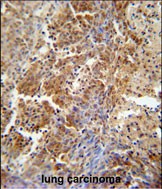ERCC8 Antibody (Center)
Affinity Purified Rabbit Polyclonal Antibody (Pab)
- 产品详情
- 实验流程
- 背景知识
Application
| WB, IHC-P, E |
|---|---|
| Primary Accession | Q13216 |
| Other Accession | NP_000073.1 |
| Reactivity | Human, Mouse |
| Host | Rabbit |
| Clonality | Polyclonal |
| Isotype | Rabbit IgG |
| Calculated MW | 44055 Da |
| Antigen Region | 210-238 aa |
| Gene ID | 1161 |
|---|---|
| Other Names | DNA excision repair protein ERCC-8, Cockayne syndrome WD repeat protein CSA, ERCC8, CKN1, CSA |
| Target/Specificity | This ERCC8 antibody is generated from rabbits immunized with a KLH conjugated synthetic peptide between 210-238 amino acids from the Central region of human ERCC8. |
| Dilution | WB~~1:1000 IHC-P~~1:100~500 E~~Use at an assay dependent concentration. |
| Format | Purified polyclonal antibody supplied in PBS with 0.09% (W/V) sodium azide. This antibody is purified through a protein A column, followed by peptide affinity purification. |
| Storage | Maintain refrigerated at 2-8°C for up to 2 weeks. For long term storage store at -20°C in small aliquots to prevent freeze-thaw cycles. |
| Precautions | ERCC8 Antibody (Center) is for research use only and not for use in diagnostic or therapeutic procedures. |
| Name | ERCC8 {ECO:0000303|PubMed:19894250, ECO:0000312|HGNC:HGNC:3439} |
|---|---|
| Function | Substrate-recognition component of the CSA complex, a DCX (DDB1-CUL4-X-box) E3 ubiquitin-protein ligase complex, involved in transcription-coupled nucleotide excision repair (TC-NER), a process during which RNA polymerase II-blocking lesions are rapidly removed from the transcribed strand of active genes (PubMed:12732143, PubMed:16751180, PubMed:16964240, PubMed:32142649, PubMed:34526721, PubMed:38316879, PubMed:38600235, PubMed:38600236). Following recruitment to lesion-stalled RNA polymerase II (Pol II), the CSA complex mediates ubiquitination of Pol II subunit POLR2A/RPB1 at 'Lys- 1268', a critical TC-NER checkpoint, governing RNA Pol II stability and initiating DNA damage excision by TFIIH recruitment (PubMed:12732143, PubMed:16751180, PubMed:16964240, PubMed:32142649, PubMed:32355176, PubMed:34526721, PubMed:38316879, PubMed:38600235, PubMed:38600236). The CSA complex also promotes the ubiquitination and subsequent proteasomal degradation of ERCC6/CSB in a UV-dependent manner; ERCC6 degradation is essential for the recovery of RNA synthesis after transcription-coupled repair (PubMed:16751180). Also plays a role in DNA double-strand breaks (DSSBs) repair by non-homologous end joining (NHEJ) (PubMed:29545921). |
| Cellular Location | Nucleus. Chromosome Nucleus matrix. Note=Recruited to lesion- stalled RNA polymerase II (Pol II) sites by ERCC6/CSB (PubMed:32355176). UV-induced translocation to the nuclear matrix is dependent on ERCC6/CSB (PubMed:26620705). |
For Research Use Only. Not For Use In Diagnostic Procedures.
Provided below are standard protocols that you may find useful for product applications.
BACKGROUND
This gene encodes a WD repeat protein, which interacts with Cockayne syndrome type B (CSB) protein and with p44 protein, a subunit of the RNA polymerase II transcription factor IIH. Mutations in this gene have been identified in patients with hereditary disease Cockayne syndrome (CS). CS cells are abnormally sensitive to ultraviolet radiation and are defective in the repair of transcriptionally active genes.
REFERENCES
Briggs, F.B., et al. Am. J. Epidemiol. 172(2):217-224(2010)
Guillem, V.M., et al. Am. J. Hematol. 85(7):482-486(2010)
Monsees, G.M., et al. Breast Cancer Res. Treat. (2010) In press :
Kamenisch, Y., et al. J. Exp. Med. 207(2):379-390(2010)
Laugel, V., et al. Hum. Mutat. 31(2):113-126(2010)
终于等到您。ABCEPTA(百远生物)抗体产品。
点击下方“我要评价 ”按钮提交您的反馈信息,您的反馈和评价是我们最宝贵的财富之一,
我们将在1-3个工作日内处理您的反馈信息。
如有疑问,联系:0512-88856768 tech-china@abcepta.com.























 癌症的基本特征包括细胞增殖、血管生成、迁移、凋亡逃避机制和细胞永生等。找到癌症发生过程中这些通路的关键标记物和对应的抗体用于检测至关重要。
癌症的基本特征包括细胞增殖、血管生成、迁移、凋亡逃避机制和细胞永生等。找到癌症发生过程中这些通路的关键标记物和对应的抗体用于检测至关重要。 为您推荐一个泛素化位点预测神器——泛素化分析工具,可以为您的蛋白的泛素化位点作出预测和评分。
为您推荐一个泛素化位点预测神器——泛素化分析工具,可以为您的蛋白的泛素化位点作出预测和评分。 细胞自噬受体图形绘图工具为你的蛋白的细胞受体结合位点作出预测和评分,识别结合到自噬通路中的蛋白是非常重要的,便于让我们理解自噬在正常生理、病理过程中的作用,如发育、细胞分化、神经退化性疾病、压力条件下、感染和癌症。
细胞自噬受体图形绘图工具为你的蛋白的细胞受体结合位点作出预测和评分,识别结合到自噬通路中的蛋白是非常重要的,便于让我们理解自噬在正常生理、病理过程中的作用,如发育、细胞分化、神经退化性疾病、压力条件下、感染和癌症。







